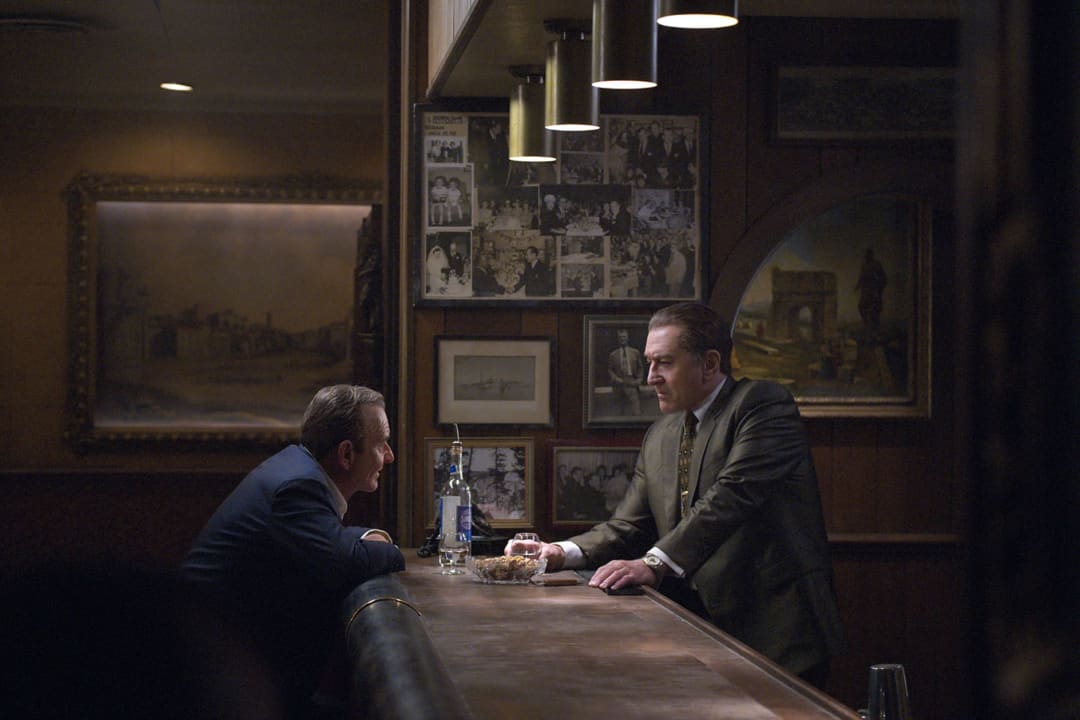The Irishman is not a typical Martin Scorsese gangster movie. It is also named I Heard You Paint Houses, a reference to the coded question which potential employers ask for-hire assassins — a tantalizing glimpse into its plot.
Many of Scorsese’s most famous films, like Goodfellas and The Wolf of Wall Street, are tales of when crime does pay, and ultimately condemn the systems and actors that perpetuate criminal activity. The Irishman offers a different, and perhaps more mature, perspective. By stripping away the mystique and glamour of criminal involvement, the film gives a melancholic look at a life of crime through the lens of aging and regret.
The Irishman follows Robert De Niro’s Frank Sheeran, the Irishman himself, from his thirties working as a truck driver, to his fifties, as both a hitman for the Bufalino crime family and confidant to famous union leader Jimmy Hoffa (Al Pacino). Sheeran’s dealing with the frequent and messy intersection between his two worlds is one of the central tensions of the film. Frank is not an outwardly emotional character, but De Niro excellently captures his inner struggles. We’re witness to his life all the way to his eighties, where, at the end, he sits in a hospice, waiting to die, narrating the story of his life.
The most striking feature of the movie is likely its enormous runtime of 209 minutes, clocking in just below three-and-a-half hours. It definitely could have been shorter, but the length feels justified on the whole. The extended runtime allows the film to create a huge level of depth. We really get to know Sheeran, the many colourful characters that he orbits, and their complex relationships to each other. In this regard, the film has an impressively fast pace and is greatly entertaining.
The Irishman also gives some of the best film performances of the year. Joe Pesci as Russell Bufalino, Sheeran’s best friend within the mob, is intense and terrifying through his calm secretiveness. Pacino gives a great comedic performance as Hoffa, whose emotional outbursts provide a refreshing contrast with the other, more closed-off leads.
Steve Zaillian’s script is a significant part of what makes The Irishman so great. It’s a complete, excellently crafted package, and a structural wonder. The classic Scorsese back-and-forth framing device, this time delivered to us by Sheeran’s self-reflecting narration during the end of his life, is one of the greatest factors in making this epic feel brisk and constantly engaging.
The script gradually recontextualizes itself in interesting and rewarding ways. There are so many plot threads and minor characters that the level of complexity could be overwhelming as a viewer, but Zaillian and Scorsese weave these parts together seamlessly. Over the story of Sheeran’s life there is a wealth of great single-scene characters, and an impressive number of them receive pay-offs, sometimes hours after their last appearance.
It’s extremely satisfying to see the plot resolved in such a complicated story.
The dialogue is also fantastic. Each of the major characters are so fully realized and wonderfully written that their arguments always feel like genuine clashes. It’s clear how each character’s personality directly leads into everything they do.
Another aspect of the film sure to draw attention is the use of digital de-aging effects, which skyrocketed the budget to rank among action blockbusters. De Niro is 76 years old, so no amount of makeup and suspension of disbelief could convincingly turn back the clock as far as the film needed. Yet, the digital effects are also not perfect. Especially in the beginning of the film, when De Niro was younger, they were particularly egregious, but overall much more believable than traditional methods.
Pesci and Pacino receive the same digital makeover, and it was almost seamless. However, this relative success might be attributed to the fact that their transformation needed to be less drastic than De Niro’s. Overall, the effects were well done, and didn’t distract me once I had settled into them.
Having these effects lets Scorsese guide us freely through Sheeran’s life, and gives the film a greater sense of gradual progression. Literally seeing the characters grow old in front of our eyes is incredible.
The film deals heavily with the men aging — what it does to people physically and emotionally, and what really matters at the end of one’s life. The final chapter of both the film and Sheeran’s life ties the whole story together in a beautiful way, harnessing everything that came before to create catharsis.
While the lead-up is excellent on its own, this finale is what really elevates the movie to another level. Simply put, Scorsese’s The Irishman is one of the best films of the year. Watching it might seem daunting, but fully committing to it is an extremely rewarding experience, and certainly not one you should miss.
The monstrous runtime will certainly be a deterrent for many to see it in theatre. It does seem well suited for a multi-part home viewing. However, an epic like this doesn’t come around all that often, and deserves to be seen in the immersive, shared space of a theatre. So until then, head to the cinema while you still have the chance!
The Irishman is in theatres now at the TIFF Bell Lightbox. The film will premiere on Netflix on November 27.


